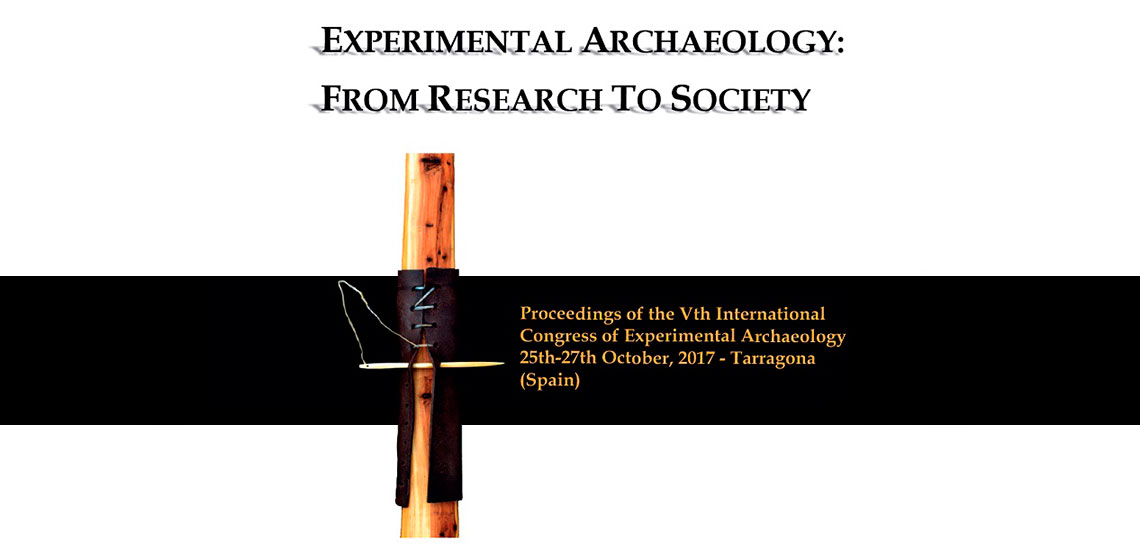
“Experimental Archaeology: from Research to Society” is a transcript of the proceedings of the Vth International Congress of Experimental Archaeology in Tarragona, Spain, on the 25-27th October 2017. The conference, organized by Experimenta (Asociación Española de Arqueología Experimental), the Institut Català de Paleoecologia Humana i Evolució Social (IPHES), the Institut Català d’Arqueologia Clàssica (ICAC) and the Institut Català de Recerca en Patrimoni Cultural (ICRPC), should be considered within the scope of the programme of affirmation and development of the practices of experimental archaeology in Spain, a programme that consists of 12 years of activities. In fact (and as mentioned in the presentation) this initiative, that has now materialized in this book, attests to the “growing vitality of experimentation in Archeology” (Cáceres et al. 2018, 10) in Spain.
The forty-seven contributions to this book, mostly produced in Spanish (more than 65%), result in a collection of case studies covering a wide range of themes and a broad temporal spectrum, which lead us to focus this analysis on the structuring of the work in sections.
The most representative section in the book integrates the essays and experiments related to artefacts and practices of prehistoric communities, with a predominance of approaches to lithic utensils and the registration of their respective “chaînes opératoires”. However, studies on ceramic, bone, wood and metal objects are also discussed, and they all present a clear pedagogical approach. In general, articles related to this section present innovative problems and points of view, such as the importance of communication processes in the transmission of knowledge (Lombao et al., 25-31) or the preparation of musical instruments (Genera I Monells et al., 211-217; Monteagudo et al., 219-224). In the context of case studies of objects and ancestral communities’ practices, especially the sets of items whose chronologies point to the Metal Ages and the Roman Period and those that mention ancient construction techniques deserve note.
The book also includes a set of articles about the presentation of research projects, promotion, and dissemination of archaeological heritage, in line with the international trends of heritage valuation through the disclosure of scientific knowledge to the public in general. Within this set we find cases of experimental archaeology in a living history context, such as the archaeological Park of Livelet (Modolo et al., 65-71), Espai Orígens in Lleida (Marcén et al.,113-119) and the archaeological ruins of Baetulo in Badalona (Forn & Espejo, 155-161). Two articles discuss the development of experimentalism in archaeology in Spain: one focusing on the lithic and the evolution of the approach to this practice in the country (Palomo et al., 195-200); the other translating a review of the Experimental Archaeology Course (AExC) and the development of its educational dynamics along the years (Mazo et al., 329-334).
The third section is related to events of historical recreation, with the relevance of integrating activities of experimental archaeology into these initiatives of an eminently playful nature, and of collective identification with the historical heritage of the communities.
In conclusion, the diversity of themes and the direct and objective language of each article provides a positive dynamic and fluidity to the book, whose articles are well illustrated with graphics, schemes and/or coloured images, improving the quality of the publication. Note, however, that the articles are published in four languages - Spanish, English, French and Catalan - the last having limited users outside of Spain, which hinders the full enjoyment of the content.
Above all, we are presented with an excellent working tool, not only for the characteristics of the case studies but also for the systematization of the methodologies adopted and the analytical and critical character of each experience. In the same way, the projects and events listed in this work provide a clear testimony to the growing spread of experimental archaeology in Spain and Europe. For this reason, and returning to the presentation of the book: “we wish it to be long, full of adventures, full of knowledge” (Cáceres et al. 2018, 10).
Book Information:
Isabel Cáceres, Isabel Expósito, Marta Fontanals, M. Gema Chacón, Josep Maria Vergès (Eds) (2018). Experimental Archaeology: from Research to Society. Butlletí Arqueològic, V, 40, ISSN 1695-5862.